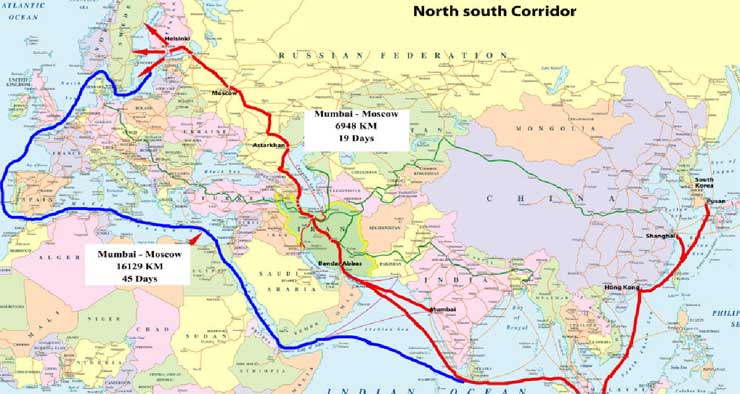Authors: Vahid Pourtajrishi & Mahdi Torabi
The strategic position of some countries in the field of transit is assumed as an economic chance for them. International transit helps to consolidate the eco-political relations between the states beside of their significant influence on the economic conditions of the origin and destination countries.
Iran’s access to the Caspian Sean in north, Persian Gulf in south and the Sea of Oman as a water corridor ending to the Indian Ocean helps to keep this country always present in international transit sphere as a connecting bridge between East and West of the world. Existence of the ancient passing ways through Iran like the Silk Road demonstrates this claim for sure.
Construction and completion of Qazvin – Rasht railway in March 2019 was a great forward step into expansion of the rail infrastructures of Iran. This project also completed a significant part of the International North – South Corridor (INSTC) as one of the ten defined rail-mixed corridors in Helsinki Summit 1992 and approved as the key actor way between the three countries of Iran, Russia and India. The initial agreement on establishment of this corridor signed in Saint Petersburg between the three mentioned states in 2000. According to the existing official documents, this corridor links the South – Asian countries to the North of Europe. In fact, after completion of INSTC, the Northern countries like Finland, as the defined destinations will get linked to India beside of linkage between the Persian Gulf and Indian Ocean countries to Europe and this could be counted as an revolution in world of international transit.

But the most significant advantage of this corridor is shortening of the way and saving time and cost for the participant countries.
The important elements in establishment of INSTC
Like any other international corridor, the INSTC also includes some eminent factors which make this corridor distinct. In continue, we try to take a look at some of these points:
Distinct role of Iran
As it is shown in the map, Iran is located in the heart of INSTC as the main passing way and bridge between North and South. According to the published info by the Iranian railways, only during 2018, more than 253000 tons of freight passed the Astara rail border of Iran into/from Azerbaijan on this corridor that this amount of freight was carried by 4094 wagons. This is a great triumph for Iran in spite of US economic sanctions against this country. We have to pay attention to this fact that, by completion of INSTC could how much help Iran to increase its GDP by transit as a sustainable way for income without rely on oil export as its main source of income.

Activation of South – West Corridor at the same time
The agreement on establish the International South – West Corridor (ISWC) was signed by the presidents of Poland, Iran, Ukraine, Georgia and Azerbaijan railways in March 2017. In fact, this project was started according to a joint trilateral idea by Iran, Azerbaijan and Georgia.
ISWC supposed to be established as a branch of INSTC but the parties agreed to create a new corridor with separate name. According to the given map below, the path of both corridors is same from India to Azerbaijan. So, it is clear that real establishment of ISWC also depends on the completion of the missing rail link in Iran. That’s why, completion of Qazvin – Rasht railway not only helps to decrease the volume of the mentioned missing link, but also it caused to achieve a great success in implementation of South – West Corridor.
According to the estimated calculations of experts, the ISWC will contain at least 2 million tons of freight at the first year of its establishment. So, if we plus this amount to 253000 tons of freight in INSTC, it could bring something more than 2.5 million tons of freight in Iran’s path.
Increase of potential competitive power of Iran versus the alternative roots
Non-completion of the North – South Corridor caused to create of new alternatives for this root. For example we can refer BTK (Baku – Tbilisi – Kars), CPEC (China – Pakistan Economic Corridor), Silk Wind that’s is passing Caspian Sea in order to connect China to Europe of the Ice Silk Road which is assumed as Russia – China joint initiation for connecting Asia and Europe from the North Sea. Of course, all of the mentioned alternatives are very costly in comparison with INSTC. Even for operating some of these roots like the Ice Silk Road, the participants need to manufacture huge and high expensive nuclear ice breakers to pass north.
Completion of Qazvin – Rasht root could make Iran closed to its long dreams as the heartland and revival of the classic Silk Road role for this country in new face.
INSTC, the new breath revive
As discussed above, gradual completion of INSTC could put Iran in the heart of the international transit roots between East and West of the world to revive the classic role of this country in the mentioned issue.
Despite of the US unlawful sanctions against Iran, we are witnessed for increase of demands in use of Iran’s transit roots, the factor which could make this country far from oil dependency. In fact the sanctions moved Iran into the non-oil economy including use of its potential in international transit as a modern successful method to make its economy sustainable.


